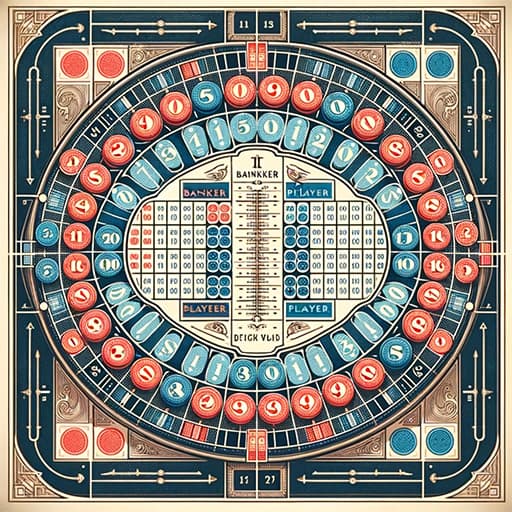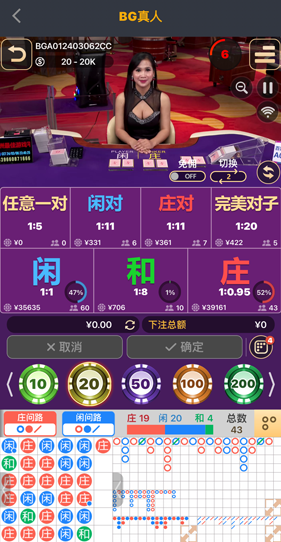Baccarat Scoreboards

The Big Road
The Big Road is a pivotal section in the display, meticulously documenting the outcomes of Player and Banker wins, while also recording instances of Tie and Pair victories through the use of distinct markings: slashes for Ties and dots for Pairs. Specifically, Ties are denoted by a green line intersecting the cell of the preceding Player or Banker win, whereas Player Pairs are indicated by a blue dot situated in the bottom right of the relevant cell, and Banker Pairs by a red dot in the top left.

In the pursuit of clarity, it is noteworthy that this example exclusively demonstrates Player and Banker wins. The method of recording begins in the upper left corner, akin to the Bead Plate, with Player wins marked in blue and Banker wins in red. Contrasting with the Bead Plate’s solid circles featuring a Chinese character at the center, the Big Road utilizes mere outlines of circles in blue and red.

A significant departure from the Bead Plate is observed in the Big Road’s method of initiating a new column at the advent of a shift in the winning party, be it Player or Banker. The grid, extending six rows deep, accommodates the documentation of up to six consecutive wins. Should there be a streak of seven or more consecutive wins for either side, the notation extends horizontally, forming a pattern colloquially referred to as a “dragon tail.” However, in the provided example, such a scenario does not occur as there were no instances of more than four consecutive wins on one side.
Big Eye Boy
The Big Eye Boy table represents a sophisticated tool in the analysis of baccarat games, where clarity and predictability become increasingly nuanced. Baccarat players, known for their superstitious nature, seek to decipher patterns and trends in the game’s outcomes. This quest for predictability is rooted in the game’s inherent patterns, such as a sequence of wins for the Banker and Player. The Big Eye Boy table is instrumental in evaluating the consistency—or lack thereof—within a game. Here, red marks indicate a repetitive sequence, whereas blue signifies variability, breaking from the associations found in previous tables.

The initiation of the Big Eye Boy table’s analysis occurs with the hand following the first entry in the Big Road’s second column, ensuring a sufficient dataset for pattern evaluation. It’s crucial to understand that each notation within the Big Eye Boy table directly correlates to specific outcomes documented in the Big Road, thus requiring meticulous attention.
For entries in the Big Eye Boy table, the methodology is as follows:
A new column in the Big Road prompts a comparison of the depth of the two preceding columns. Identical depths result in a red notation in the Big Eye Boy, while disparities are marked blue. Should a hand maintain the preceding outcome (excluding ties), the analysis involves comparing the cell to the left of this new entry against the cell directly above. Matching cells, whether they indicate Player, Banker, or are blank, are denoted in red in the Big Eye Boy. A discrepancy marks the entry in blue. This process, which meticulously tracks changes and continuities in game outcomes, becomes particularly poignant when addressing scenarios of extended win streaks, known as “dragon tails.” For such occurrences, it’s assumed the Big Road extends indefinitely, facilitating analysis for the Big Eye Boy, Small Road, and Cockroach Pig tables.
An illustrative example clarifies this complex analysis: the first entry in the Big Eye Boy, linked to the same hand in the Big Road’s cell C1, examines whether the preceding two columns match in length. A match is indicated in red for Big Eye Boy’s cell A1, reflecting consistency in the game’s pattern.
This detailed breakdown not only showcases the intricacies involved in tracking and interpreting baccarat outcomes but also underscores the deep analytical approach adopted by players to navigate the game’s inherent unpredictability.
Small Road
The “Small Road” table offers a nuanced analysis of baccarat outcomes, functioning similarly to the Big Eye Boy but with a distinct approach to examining the Big Road. The Small Road differentiates itself by omitting the immediate column to the left of the current column on the Big Road, necessitating the examination to begin only after the first entry in the Big Road’s third column. This specific methodology ensures a comprehensive dataset for accurate pattern analysis.
 The recording process for the Small Road is as follows:
The recording process for the Small Road is as follows:
When a new column emerges in the Big Road, the analysis involves comparing the depth of the first and third columns to the left of this new column. A match in depth results in the notation of a red circle on the Small Road, whereas a difference is denoted with a blue circle. If the outcome remains consistent with the previous hand (excluding ties), the examination shifts to the cell two positions to the left of the new entry in the Big Road and the cell directly above it. Identical outcomes in these positions, whether indicating Player, Banker, or being unmarked, are represented by a red mark on the Small Road. A discrepancy between these cells results in a blue mark. To simplify, the procedure entails assessing the most recent Big Road entry, moving two cells to the left, and then moving up one cell. A lack of change in this sequence warrants a red notation, while any alteration is marked in blue.
Cockroach Pig
The “Cockroach Pig” table offers a unique perspective on analyzing baccarat outcomes, functioning under a methodology akin to the Small Road but with a further distinction. The Cockroach Pig differentiates its analysis by bypassing two columns to the left of the current column on the Big Road. This necessitates that the analysis commence only after surpassing the first entry in the Big Road’s fourth column, ensuring a robust dataset for pattern assessment.
 The recording criteria for the Cockroach Pig are as follows:
The recording criteria for the Cockroach Pig are as follows:
Upon the formation of a new column in the Big Road, the analysis involves a comparison between the depths of the first and fourth columns to the left of this new column. A congruence in depth is indicated with a red circle on the Cockroach Pig, while a disparity is marked by a blue circle. For outcomes that mirror the immediate preceding hand (excluding ties), the procedure involves comparing the cell located three spaces to the left of the new entry in the Big Road against the cell directly above. Should these cells present identical outcomes, be it Player, Banker, or neither, a red mark is recorded on the Cockroach Pig. In the case of a variance, a blue mark is applied. Simplified, this entails examining the most recent Big Road entry, moving three cells to the left, and then moving up. A stationary outcome in this sequence prompts a red notation, whereas any deviation is captured in blue.
This approach underscores the Cockroach Pig’s capacity to provide insightful analysis into the dynamic patterns of baccarat games, adapting a strategic lens that emphasizes the importance of pattern recognition and the detection of deviations within the flow of the game.
